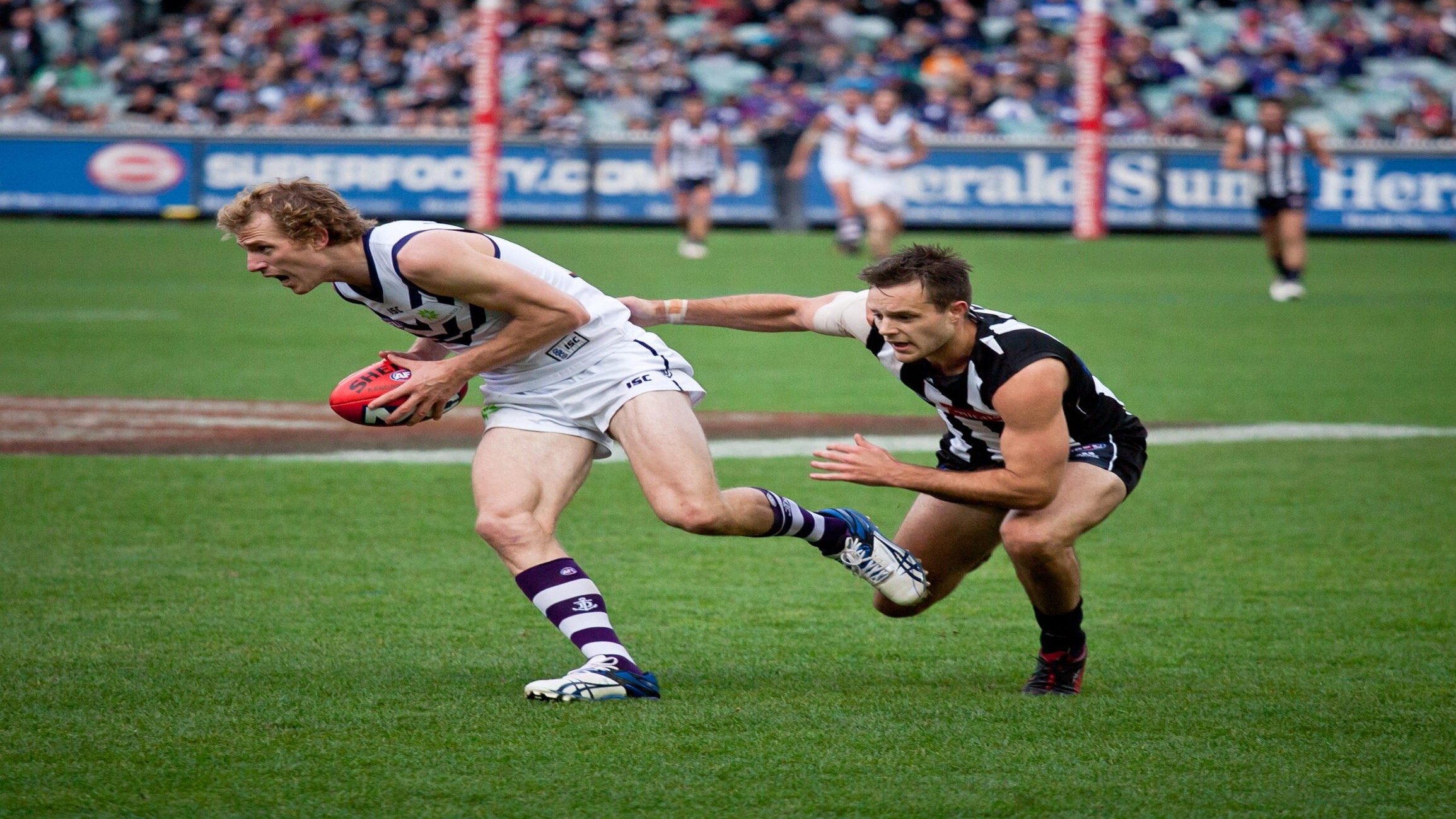
Why the massive injury rate in AFL football at the moment? This is a question that has been posed numerous times by many fans during this shortened and unique AFL football season. Certainly the team physio’s, doctors and sports scientists were all well aware that this season was going to pose some real issues with not only soft tissue injuries, but also some of the more devastating injuries such as ACL’s.
Is it the condensed pre-season? The lack of contact during much of the allowed pre season? The length of games? The short turnaround between games? This is something that will no doubt be studied in depth once the full season statistics are available, but for now, as the season approaches the peak of the even more condensed game schedule, injuries do seem to be playing a big role and we are regularly seeing players seasons ending with soft tissue injury concerns.
The AFL knew when COVID hit that the revised season was going to be a soft tissue injury minefield. So let’s have a look at why.
THE SHORT PRE SEASON
AFL players usually start training somewhere around mid November, give or take a week or two. This gives around 12 weeks for players to be fit enough for practice games. And don’t forget that during this post season “break”, whilst players are not allowed to train at their clubs, there is a strong expectation that the players turn up to day 1 of pre-season “ready to go”! So, in effect, that 12 weeks of pre -season is more like 16 or 18 weeks with the combined amount of personal and club training. When COVID hit hard in March after only one AFL game had been played, games did not resume until early June, the 11th to be exact.
But consider this, teams were only allowed to train together (with restrictions) from May 18, and full contact training allowed from May 25th. The players basically had just over 3 weeks of modified training to get match fit again, and just over 2 weeks of contact training. This was always going to be an unfortunate recipe for disaster: you simply cannot fit 18 weeks of pre-season into 3 weeks of modified training: the players were always going to be susceptible to injury! It’s almost like trying to train for the Melbourne Marathon with only 3 weeks preparation – most of us wouldn’t even get to the start line.
SHORTER QUARTERS
Many other sporting leagues made big concessions to normal playing regulations – world soccer allowed an extra substitute, NBA basketball allowed extra player signings to boost lists, however the AFL wasn’t keen on an extra bench player. They chose to shorten the quarters by 20%, or 4 minutes, down to 16 minutes per quarter. The foundations of this decision were based upon the fact that shorter quarters means less body stress, less total contacts, less sprint efforts, less time on ground, and less fatigue (amongst other benefits). And remember, the players weren’t as magnificently conditioned as they usually are after a full pre season, so shorter quarters compensated in some way for lower fitness levels.
However the question must be asked: “Does less game time mean more intensity”? You wouldn’t think so judging by some of the terrible scoring, however in any competitive event, with less available time, intensity can often be at higher levels. So whilst the shorter quarters makes a lot of sense, and no doubt helps, I’m not sure in some strange way that maybe it contributes to the soreness that the players experience through higher intensity.
There is in fact some evidence to support this unfortunate by-product of shorter quarters. Have a look at the table below (thanks to https://www.trackademicblog.com/blog/familiarfoesfastfooty for the graphic):

You can see from the graphic above that clearly many of the running metrics HAVE INCREASED this season compared to last season – the intensity seems undeniably higher! Judging by this, the players may need MORE recovery time, not LESS!
QUICK TURNAROUND TIMES
The AFL knew that there was an enormous probability COVID would impact more, and that the fixture would have to be condensed at some point. That is why they only release a segment of the fixture at a time. And that condensed point certainly arrived with some weeks having games every night, and some turnaround times for teams as short as four days – 33 games in 19 days at its most condensed time! Such incredibly short recovery times meant players could not be pushed to their normal game time limits every week. Being such an incredibly physical game, recovery in four days might be possible for some players, and maybe once or twice in succession, but it is a tough ask for weeks on end. Especially if you’re “old”, which in AFL parlance is pretty much anyone 28yo and above!
It has been shown in European soccer that teams with 3 days or less of recovery have muscle injury rates that are 20% higher than teams with the usual AFL 6-10 day break. And there is no reason to suspect the statistics wouldn’t be very similar in the brutally physical world of AFL football, if not higher.
ALTERED RECOVERY TECHNIQUES
Whilst living in a Queensland hub might seem like bliss to all us locked down Melburnian’s, it does present logistical nightmares for clubs. AFL clubs these days are world class recovery centres (as well as training venues) so hub life produces barriers and hurdles that must be overcome. The physio’s and sports scientists at clubs are world class, and enormous consideration and time will be going into ensuring players recover as best as possible. Whilst I don’t think this is a big cause of injuries, it’s just another small factor that must be factored in at a time when players would be needing every ounce of recovery benefit they could get.
NO RESERVES COMPETITION
As if it’s not hard enough, all second tier competitions have been called off, so clubs are madly trying to organise scratch matches with other clubs, or intra club match type practice with the few players left who aren’t selected. In a season where maintaining high loads is as important as recovery (and the highest loads always come from games) it is very hard to keep players who aren’t selected as match fit and toughened as they need to be when called on to play – yet another injury risk.
PREVIOUS INJURY
What is consistent across this incredible season is the rate of hamstring injuries. Once again, thanks to Tracademic for the stat’s: the rate of hamstring injuries since the restart in June is .38 per game, compared with .22 per game for the same rounds last year. And the rate was .61 hamstring injuries occurring per game across rounds 4-6. What is not surprising is the fact that many of these hamstring injuries have been in players that have had previous hamstring strains. One of the biggest risk factors for hamstring strain is… a past history of hamstring strain! Incredibly, 85% of the 2020 AFL hamstring strains have occurred in players who have a history! Given all the above factors of our COVID condensed season, it is little wonder the poor old hamstring suffers again.
And condensed rounds probably come into play here too – we have become a lot smarter over the years, realising that there is no set time frame for a hammy (remember the old standard 14 day rule, which then became 21)? It’s hard enough telling a footballer with a 3 week hamstring strain that they will miss 3 games – imagine telling them that their “3 week hammy” means they’ll miss 5 games (in a shorter 18 round season to boot)! Once again, the AFL staff are the best at their game, but perhaps it does tempt players to run the gauntlet and think more about “games missed” than “weeks missed”. Might also explain the high rate of reinjury this year in players coming back for their first game after a hamstring strain.
My Verdict?
Well it’s a tough one. What an incredible season, and one I hope we never see again! Whilst all of the above factors will contribute to injury rate, I look at it and think “What single factor above could I change to have the greatest impact on injury rate”? We can’t change “previous Injury” so that’s out. For me, it is turnaround time. If we could increase the recovery time for players, by increasing the days between games, I think we would see a large reduction in soft tissue injuries. Obviously it isn’t possible in the essential need to get a season completed. I think we would cope a lot better with the shorter pre-season, the higher intensity/shorter quarters, the altered recovery techniques, and the lack of reserves competition… if only we had a bit more time between games!
Anthony Lance
SSPC Physiotherapist
Ref: https://www.trackademicblog.com/blog/familiarfoesfastfooty
You might like these other resources
Why Do My Joints Ache In Cold Weather?
11 June 2025
The Role of Ice in Managing Acute Sporting Injuries
17 September 2024
Are Your Bones Strong Enough?
28 May 2024





